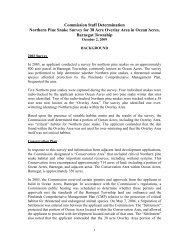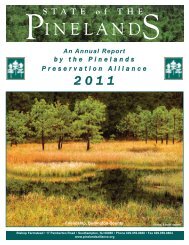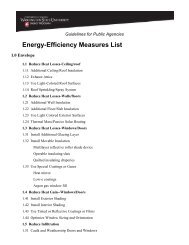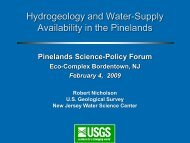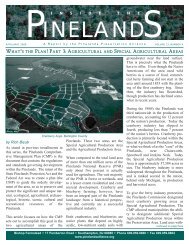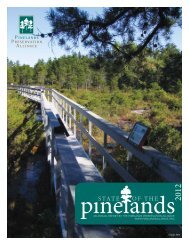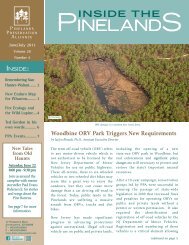A Guide to Native Plant Landscaping in the New Jersey Pinelands
A Guide to Native Plant Landscaping in the New Jersey Pinelands
A Guide to Native Plant Landscaping in the New Jersey Pinelands
You also want an ePaper? Increase the reach of your titles
YUMPU automatically turns print PDFs into web optimized ePapers that Google loves.
Produced by P<strong>in</strong>elands Preservation Alliance17 Pember<strong>to</strong>n Road, Southhamp<strong>to</strong>n, NJ 08088 – Phone 609.859.8860In partnership with:P<strong>in</strong>elands Nursery & Supply – www.p<strong>in</strong>elandsnursery.com – 800-667-2729Builders League of South <strong>Jersey</strong> – blsj-nj.builderfusion.com/bf/web/<strong>in</strong>dex.html – 856-616-8460Lip<strong>in</strong>ski Outdoor Services, – www.lip<strong>in</strong>skiland.com – 800-524-2305
But Aren’t Fertilizers Good for <strong>Plant</strong>s?Fertilizers are kill<strong>in</strong>g <strong>the</strong> P<strong>in</strong>e Barrens. This mayseem paradoxical, but it’s true. The P<strong>in</strong>e Barrensis dist<strong>in</strong>ctive because its natural soil and waterconditions are very acidic and low <strong>in</strong> nutrients(nitrogen, potassium and phosphorous). <strong>Native</strong>plants and animals are those that have adapted <strong>to</strong><strong>the</strong>se conditions. Add<strong>in</strong>g nutrients or neutraliz<strong>in</strong>g<strong>the</strong> naturally acidic soil changes <strong>the</strong> chemicalproperties of <strong>the</strong> soil, negat<strong>in</strong>g <strong>the</strong> conditionsthat make this area <strong>the</strong> P<strong>in</strong>e Barrens. This no<strong>to</strong>nly suppresses many native species, but alsoopens <strong>the</strong> door <strong>to</strong> <strong>in</strong>vasive species that cansuppress or even replace native plant andanimal communities. In and around <strong>the</strong>P<strong>in</strong>elands, it is best <strong>to</strong> allow nature <strong>to</strong> take it’scourse and put away <strong>the</strong> fertilizers and lime.Critter ControlIf you live <strong>in</strong> a characteristic P<strong>in</strong>e Barrens area,one of <strong>the</strong> biggest keys <strong>to</strong> successful nativelandscap<strong>in</strong>g is controll<strong>in</strong>g <strong>the</strong> animals —especially deer — that want <strong>to</strong> eat your plants.You probably have a wonderful diversity of nativeplants <strong>in</strong> and around your landscape, but if deervisit your property you may need <strong>to</strong> take steps <strong>to</strong>control deer brows<strong>in</strong>g. S<strong>in</strong>ce deer will eat virtuallyany native plant, <strong>the</strong> most effective strategy is <strong>to</strong>exclude <strong>the</strong>m from <strong>the</strong> portions of your yardthat you want <strong>to</strong> cultivate.Deer can be excluded (or at least effectivelydiscouraged) ei<strong>the</strong>r by sett<strong>in</strong>g up electric fenc<strong>in</strong>gor by <strong>in</strong>stall<strong>in</strong>g a 7-8 foot high fence. Various typesof deer fenc<strong>in</strong>g are available commercially. Onera<strong>the</strong>r unobtrusive type is a black plastic meshthat virtually disappears when viewed from adistance. This can effectively exclude <strong>the</strong> deerwhile ma<strong>in</strong>ta<strong>in</strong><strong>in</strong>g an open andnatural-look<strong>in</strong>g landscape.Why Go <strong>Native</strong> <strong>in</strong> <strong>the</strong> P<strong>in</strong>elands?Your yard is a part of <strong>the</strong> wider landscape <strong>in</strong> which you live. It canbe a haven for native plants and animals, or an island of alien speciesliv<strong>in</strong>g here only because we have created artificial conditions <strong>in</strong>which <strong>the</strong>y can survive and displace native flora.Your lawn can beat one with <strong>the</strong> natural P<strong>in</strong>elands ecosystem, or it can be a beachheadfor <strong>in</strong>vasive species and an open<strong>in</strong>g through which humanpollutants flow <strong>in</strong><strong>to</strong> <strong>the</strong> soil, <strong>the</strong> aquifer, steams, and wetlands.Most of our yards will fit both pictures <strong>to</strong> some degree.Thisguide aims <strong>to</strong> help you make your property an asset <strong>to</strong> <strong>the</strong> naturalcommunity of <strong>the</strong> P<strong>in</strong>elands, while avoid<strong>in</strong>g harm as much as possible.There are lots of reasons <strong>to</strong> plant native plants anywhere you live– but <strong>the</strong>se reasons are even stronger if you live <strong>in</strong> and around <strong>the</strong>P<strong>in</strong>elands. In this region, our acidic, low-nutrient soils make it all<strong>the</strong> more important <strong>to</strong> go native. <strong>Native</strong> species do better because<strong>the</strong>y are adapted <strong>to</strong> our unusual soil conditions, and tak<strong>in</strong>g care of<strong>the</strong>se plants does not cause <strong>the</strong> environmental harm that fertiliz<strong>in</strong>gand water<strong>in</strong>g non-natives generally br<strong>in</strong>gs <strong>to</strong> our aquifers and <strong>the</strong>vulnerable P<strong>in</strong>e Barrens ecosystem.Here’s a quick run-down of <strong>the</strong> reasons<strong>to</strong> go native <strong>in</strong> and around <strong>the</strong> P<strong>in</strong>elands:• Help save <strong>the</strong> unique botanical heritageof this extraord<strong>in</strong>ary region.• Reduce your water<strong>in</strong>g costs.• Reduce <strong>the</strong> time and moneyyou spend on ma<strong>in</strong>tenance andreplac<strong>in</strong>g unsuccessful plants.• Reduce or elim<strong>in</strong>ate <strong>the</strong> need<strong>to</strong> spray pesticides.• Reduce or elim<strong>in</strong>ate <strong>the</strong> need <strong>to</strong>add fertilizers or lime <strong>to</strong> <strong>the</strong> soil.• Attract native species of birdsand butterflies.• Cultivate a garden at one with <strong>the</strong>land <strong>in</strong> which you live.There’s No Place QuiteLike It: The P<strong>in</strong>elands’Unique BotanicalHeritageThe <strong>New</strong> <strong>Jersey</strong> P<strong>in</strong>elands ishome <strong>to</strong> plant communitiesfound nowhere else on earth,and a grow<strong>in</strong>g number of<strong>in</strong>dividual species canbe found only <strong>in</strong> ourP<strong>in</strong>elands, because <strong>the</strong>yhave been or are be<strong>in</strong>gwiped out <strong>in</strong> <strong>the</strong> res<strong>to</strong>f <strong>the</strong>ir natural range.The community ofplants found herealso does not existanywhere else, as <strong>the</strong> <strong>New</strong> <strong>Jersey</strong>P<strong>in</strong>elands is a unique mixture of sou<strong>the</strong>rn andnor<strong>the</strong>rn species that found a haven here after<strong>the</strong> last ice age and <strong>the</strong> warm<strong>in</strong>g cycles of <strong>the</strong> past 10,000 years.All this means that we have someth<strong>in</strong>g very special <strong>to</strong> protect –and even cultivate.The <strong>New</strong> <strong>Jersey</strong> P<strong>in</strong>e Barrens isn’t barren at all. It’s just different frommost o<strong>the</strong>r regions of North America. It was called barren by earlyEuropean settlers who found <strong>the</strong>y could not grow <strong>the</strong>ir row crops <strong>in</strong><strong>the</strong> sandy, droughty, low-nutrient upland soils.The negativeepi<strong>the</strong>t stuck, creat<strong>in</strong>g <strong>the</strong> false impression that th<strong>in</strong>gsdon’t grow <strong>in</strong> <strong>the</strong> P<strong>in</strong>e Barrens.In fact, beyond <strong>the</strong> familiar p<strong>in</strong>es and oaks of ourforests, <strong>the</strong> <strong>New</strong> <strong>Jersey</strong> P<strong>in</strong>e Barrens ecosystem hasabout 800 species of flower<strong>in</strong>g plants and 25 speciesof fern.We have beautiful wildflowers – some common,some very rare even <strong>in</strong> <strong>the</strong> heart of <strong>the</strong> P<strong>in</strong>elands –and we have several species of carnivorous plants, like<strong>the</strong> pitcher plant and sundews. Numerous species arecommercially available and easily cultivated.We havebeautiful and useful shrubs, like Highbush Blueberryand Low Blueberry, Swamp Azalea, and Mounta<strong>in</strong> Laurel.(Many species that could be cultivated are not yet easily available,but organizations like <strong>the</strong> P<strong>in</strong>elands Preservation Alliance andsome nurseries are work<strong>in</strong>g <strong>to</strong> expand <strong>the</strong> supply.) Even whenyou plant common native species, you are help<strong>in</strong>g conserve <strong>the</strong>rarer species by us<strong>in</strong>g plants that are compatible with – will notdisplace – o<strong>the</strong>r natives.Pr<strong>in</strong>ciples for Your Garden To Live By• Each plant <strong>in</strong> <strong>the</strong> right place: be sure <strong>to</strong> follow ourguidance on <strong>the</strong> right conditions for each plant, whe<strong>the</strong>rsun or shade, and dry or moist soil.• Design with nature by creat<strong>in</strong>g habitats throughyour garden<strong>in</strong>g.• Remove exotic and <strong>in</strong>vasive species wherever you can(see below).• Water only when you are establish<strong>in</strong>g a plant<strong>in</strong>g, or whenyour plants show signs of stress.• If you use a spr<strong>in</strong>kler system, <strong>in</strong>stall an au<strong>to</strong>matic ra<strong>in</strong>gauge <strong>to</strong> prevent water<strong>in</strong>g when it’s ra<strong>in</strong><strong>in</strong>g or when<strong>the</strong> soil already has adequate moisture..• Install drip irrigation or soaker hoses for more efficientuse of water and <strong>to</strong> prevent excessive water<strong>in</strong>g and loss ofwater through evaporation from overhead spr<strong>in</strong>kler systems.• Elim<strong>in</strong>ate <strong>the</strong> use of fertilizers, lime, and pesticides,or reduce <strong>the</strong>ir use as much as you can.– Tolerate low levels of <strong>in</strong>sects (it’s natural!).– If you use pesticides, do focused spot treatmentsof <strong>in</strong>fected plants and–Try <strong>the</strong> least-<strong>to</strong>xic method, such as horticulturaloils, <strong>in</strong>secticidal soaps, biological controls (Bacillusthur<strong>in</strong>giensis -BT), and v<strong>in</strong>egar (<strong>to</strong> kill orsuppress weeds).• Mulch: Use composted wood chips or p<strong>in</strong>e needles formulch.They don’t add chemicals <strong>to</strong> <strong>the</strong> environment,and <strong>the</strong>y provide a natural, slow release of nutrients.• Recycle your clipp<strong>in</strong>gs by mak<strong>in</strong>g compost,and leavegrass clipp<strong>in</strong>gs <strong>in</strong> place <strong>to</strong> naturally fertilize your lawn.Avoidcutt<strong>in</strong>g your lawn <strong>to</strong>o low (scalp<strong>in</strong>g) <strong>to</strong> improve lawn vigorand reduce weed competition.
<strong>Native</strong>s and Cultivars:What’s In a Name?<strong>Native</strong> plants are those that came and flourishedhere without human help because <strong>the</strong>y areadapted <strong>to</strong> local conditions of climate andsoil. In many cases, <strong>the</strong>se native species havebeen cultivated and hybridized by peopleseek<strong>in</strong>g <strong>to</strong> make <strong>the</strong>m showier, hardier, talleror shorter. Cultivars are not strictly native,but are, <strong>in</strong> some cases, very close <strong>to</strong> <strong>the</strong>native species. Some cultivars of native speciesmay be good choices for your garden, but youhave <strong>to</strong> be sure <strong>the</strong> plant you buy is really acultivar of a native species, and not some o<strong>the</strong>rplant with an ambiguous common name. To dothis, take <strong>the</strong> full scientific name – as <strong>in</strong> Kalmialatifolia for Mounta<strong>in</strong> Laurel – with you when youshop for plants, and confirm from <strong>the</strong> tag or labelon <strong>the</strong> plant that it is <strong>the</strong> species you want. Cultivarsshould be identified with an additional name,as <strong>in</strong> Kalmia latifolia Bravo or Kalmia latifoliaP<strong>in</strong>k Charm. Cultivars of native species are notnecessarily well-adapted <strong>to</strong> <strong>the</strong> typical conditionsof true natives, so it’s a good idea <strong>to</strong> do someresearch before buy<strong>in</strong>g.P<strong>in</strong>elands vs. P<strong>in</strong>e BarrensThese terms are often confused, but here is <strong>the</strong>right way <strong>to</strong> use <strong>the</strong>m. P<strong>in</strong>e Barrens refers <strong>to</strong> <strong>the</strong>ecosystem marked by acidic, low-nutrient soilsand waters, and <strong>the</strong> plants and animals adapted<strong>to</strong> <strong>the</strong>se conditions. P<strong>in</strong>elands refers <strong>to</strong> <strong>the</strong> areadesignated for special controls on developmentby <strong>the</strong> P<strong>in</strong>elands Protection Act. The P<strong>in</strong>e Barrensis a creation of nature; <strong>the</strong> P<strong>in</strong>elands a creationof governors and legisla<strong>to</strong>rs. The P<strong>in</strong>elandsboundary conta<strong>in</strong>s much, but by no means all,of <strong>the</strong> his<strong>to</strong>ric P<strong>in</strong>e Barrens ecosystem.Creat<strong>in</strong>g P<strong>in</strong>elands HabitatsOne of <strong>the</strong> most <strong>in</strong>terest<strong>in</strong>g and enjoyable ways <strong>to</strong> landscape is <strong>to</strong>create genu<strong>in</strong>e characteristic native P<strong>in</strong>e Barrens habitats on yourproperty.The easiest and most natural approach is simply <strong>to</strong> helpyour property – or portions of it – return <strong>to</strong> <strong>the</strong> natural habitat i<strong>to</strong>nce was.You can promote <strong>the</strong> species you most enjoy see<strong>in</strong>g andremove or discourage those you do not want.If <strong>the</strong> soils on your property have not been chemically altered(<strong>to</strong> raise <strong>the</strong> pH or add more nutrients), <strong>the</strong>n you may want <strong>to</strong> justmanage exist<strong>in</strong>g vegetation <strong>to</strong> suit your tastes. If you have extensivemowed lawn, you can s<strong>to</strong>p mow<strong>in</strong>g some areas and let <strong>the</strong> localnative plants move back <strong>in</strong>. Mow<strong>in</strong>g once a year or once everyo<strong>the</strong>r year, <strong>in</strong> <strong>the</strong> late w<strong>in</strong>ter, can be an excellent way <strong>to</strong> re-<strong>in</strong>troduce<strong>the</strong> native diversity <strong>to</strong> your property, without lett<strong>in</strong>g <strong>the</strong> area growback <strong>in</strong><strong>to</strong> brush land or forest.In areas where non-natives have been cultivated, especially if limeand fertilizer have been added, <strong>the</strong> process takes a little more timeand effort.The best way <strong>to</strong> beg<strong>in</strong> is <strong>to</strong> compare your property withadjacent or nearby natural areas.Tour a variety of local naturalareas at various times of <strong>the</strong> year and take note of <strong>the</strong> wildflowersand shrubs.A wide variety of field guides are available <strong>to</strong> help youidentify <strong>the</strong>se species. Make a list of <strong>the</strong> plants you like. Cultivat<strong>in</strong>g<strong>the</strong>se natives will probably <strong>in</strong>volve reverse-condition<strong>in</strong>g of <strong>the</strong> soil,aggressive control of non-natives, and re-<strong>in</strong>troduction of <strong>the</strong> natives.If you have conditioned your soil with lime and fertilizer, it will taketime—probably a few years—<strong>to</strong> reverse-condition it.You may f<strong>in</strong>dthat some characteristic P<strong>in</strong>e Barrens plants willnot do well <strong>in</strong> enriched soil s<strong>in</strong>ce <strong>the</strong>y are betteradapted <strong>to</strong> grow<strong>in</strong>g <strong>in</strong> acidic soils and under lownutrient levels.Also, P<strong>in</strong>e Barrens soils that havebeen enriched with compost or rich <strong>to</strong>psoil arelikely <strong>to</strong> reta<strong>in</strong> more moisture, and dry, uplandP<strong>in</strong>e Barrens species (such as Bearberry)need well-dra<strong>in</strong>ed conditions.You can hasten <strong>the</strong> process of return<strong>in</strong>g <strong>to</strong>native conditions by repeatedly cutt<strong>in</strong>g <strong>to</strong><strong>the</strong> ground and remov<strong>in</strong>g <strong>the</strong> exist<strong>in</strong>g nonnatives.Remov<strong>in</strong>g <strong>the</strong> cut vegetation (suchas grass clipp<strong>in</strong>gs) dur<strong>in</strong>g <strong>the</strong> grow<strong>in</strong>g season helps<strong>to</strong> weaken <strong>the</strong> unwanted plants, and it pulls someof <strong>the</strong> excess nutrient out of <strong>the</strong> soil. In time, <strong>the</strong>soil will tend <strong>to</strong> return <strong>to</strong> its more natural state.You can also remove non-natives by uproot<strong>in</strong>g anddiscard<strong>in</strong>g <strong>the</strong>m (or transplant<strong>in</strong>g <strong>the</strong>m <strong>to</strong> a non-P<strong>in</strong>eBarrens location).It’s important <strong>to</strong> not simply plow <strong>the</strong>munder, as this will add nutrient <strong>to</strong> <strong>the</strong> soil. Once youhave removed most of <strong>the</strong> non-native plants, you willprobably need <strong>to</strong> follow up by controll<strong>in</strong>g <strong>the</strong> seedl<strong>in</strong>gsthat are likely <strong>to</strong> emerge.This can be accomplishedby cover<strong>in</strong>g <strong>the</strong> area with black plastic for a spell.Youmay need <strong>to</strong> do this several times, as different seeds willgerm<strong>in</strong>ate at different times dur<strong>in</strong>g <strong>the</strong> grow<strong>in</strong>g season.Ano<strong>the</strong>r effective non-chemical technique for controll<strong>in</strong>g unwantedplants <strong>in</strong>volves cover<strong>in</strong>g <strong>the</strong>m with newspapers.Once most of <strong>the</strong> plantshave been removed or scalped, cover <strong>the</strong>m with three thicknesses oford<strong>in</strong>ary newspaper (avoid glossy material, as this is likely <strong>to</strong> conta<strong>in</strong>higher levels of heavy metals), and <strong>the</strong>n cover <strong>the</strong> newspapers witha few <strong>in</strong>ches of sterile sand.You can arrange <strong>the</strong> newspapers aroundplants you wish <strong>to</strong> preserve or come back later and cut through <strong>the</strong>newspapers <strong>to</strong> put <strong>in</strong> <strong>the</strong> plants you want.When you re-<strong>in</strong>troduce native plants, pay special attention <strong>to</strong> <strong>the</strong>light and moisture conditions of <strong>the</strong> area. Some P<strong>in</strong>e Barrens plantsthrive <strong>in</strong> <strong>the</strong> shade,while o<strong>the</strong>rs will prefer a location with partial sun.Some like it droughty, and o<strong>the</strong>rs are adapted <strong>to</strong> constant moisture.All <strong>the</strong> skills of landscap<strong>in</strong>g and cultivat<strong>in</strong>g plants need <strong>to</strong> beemployed when re-creat<strong>in</strong>g native P<strong>in</strong>e Barrens habitats.Wildlife Will Love Your GardenThe <strong>New</strong> <strong>Jersey</strong> P<strong>in</strong>elands provides habitat for 290+ k<strong>in</strong>ds ofbirds,<strong>in</strong>clud<strong>in</strong>g 140 species that nest with<strong>in</strong> <strong>the</strong> P<strong>in</strong>elands. Inaddition, 34 k<strong>in</strong>ds of mammals and 58 k<strong>in</strong>ds of reptiles andamphibians live here.Among <strong>the</strong> P<strong>in</strong>elands <strong>in</strong>habitants, <strong>the</strong>re areabout 21 species of birds and 19 species of reptiles and amphibianslisted by <strong>the</strong> state as threatened or endangered.There are manymore birds, plants, reptiles, butterflies, and o<strong>the</strong>r <strong>in</strong>vertebrates <strong>in</strong><strong>the</strong> P<strong>in</strong>elands listed as species of special concern.You can help P<strong>in</strong>elands creatures by plann<strong>in</strong>g your outdoorspace <strong>to</strong> <strong>in</strong>clude wildlife habitat. Quality habitat <strong>in</strong>cludes highnutrient food sources, structure, adequate shelter, water, andfreedom from <strong>to</strong>x<strong>in</strong>s and non-native preda<strong>to</strong>rs.You don’t need<strong>to</strong> be an expert gardener <strong>to</strong> create suitable habitats for wildlife.Here are some helpful guidel<strong>in</strong>es:Create a PlanLook at your yard. Decide how muchspace you really need for outdooractivities such as play areas, barbequeand picnic sites.Then decide how mucharea you can dedicate <strong>to</strong> wildlife habitat.Remember, even foundation plant<strong>in</strong>gsand beds near your enterta<strong>in</strong>mentareas can be attractive and wildlifefriendly.A spot that gets sunlight formost of <strong>the</strong> day is a great place for awildflower garden <strong>to</strong> attract butterfliesand humm<strong>in</strong>gbirds.<strong>Plant</strong> <strong>Native</strong><strong>Native</strong> plants of <strong>the</strong> P<strong>in</strong>elands have co-evolved with <strong>the</strong> wildlife.Theyprovide <strong>the</strong> proper nutrition for local residents. Some <strong>in</strong>sects, <strong>in</strong>clud<strong>in</strong>gbutterflies and moths <strong>in</strong> <strong>the</strong>ir caterpillar stage, are species specific:able <strong>to</strong> eat only certa<strong>in</strong> plants. Our native oak trees provide food for43 species of animals and many <strong>in</strong>sects, <strong>in</strong>clud<strong>in</strong>g butterflies andmoths. Many of <strong>the</strong> frequently planted exotic plants have little orno nutritive value.Create StructureBy add<strong>in</strong>g vertical structure <strong>to</strong> your plant<strong>in</strong>gs, you can support agreater diversity of birds and o<strong>the</strong>r animals.The next time you walkthrough a local woodlot, look at its structure.There are usually threeobvious levels.The lowest plants make up <strong>the</strong> groundcover and may<strong>in</strong>clude mosses, lichens, grasses, Bracken or o<strong>the</strong>r ferns, and smallshrubs such as Low Blueberry or Black Huckleberry.The next level<strong>in</strong>cludes taller shrubs such as Mounta<strong>in</strong> Laurel, Sheep Laurel, SweetPepperbush, Bayberry, Scrub Oak, and Highbush Blueberry.The tallestlevel <strong>in</strong>cludes canopy trees such as Pitch P<strong>in</strong>e, Post Oak, Red Maple,American Holly,Atlantic White Cedar, and Sour Gum. Many birds and
animals are specific <strong>to</strong> one or more level of this “house.”When creat<strong>in</strong>gplant<strong>in</strong>gs, <strong>in</strong>corporate structure by add<strong>in</strong>g new levels <strong>to</strong> <strong>the</strong> exist<strong>in</strong>gones.A trellis, arbor, or pergola, for example, support<strong>in</strong>g Wild Grapeor Virg<strong>in</strong>ia Creeper can create middle-level structure quickly.Fire SafetyThe P<strong>in</strong>e Barrens is a fire-prone and fire-adapted ecosystem. It’simportant <strong>to</strong> design your landscap<strong>in</strong>g <strong>to</strong> reduce <strong>the</strong> risk of damagefrom natural or man-made wildfires.Supply and Demand:Where Can We F<strong>in</strong>d <strong>the</strong>se <strong>Plant</strong>s?Because <strong>the</strong> sources for many of native speciesis chang<strong>in</strong>g, we list reliable sources on <strong>the</strong>P<strong>in</strong>elands Preservation Alliance web site,www.p<strong>in</strong>elandsalliance.org. If you do not haveaccess <strong>to</strong> <strong>the</strong> web, please call <strong>the</strong> Alliance <strong>to</strong>obta<strong>in</strong> a current list (see phone number below).The P<strong>in</strong>elands Preservation Alliance holds anannual native plant sale around Earth Day <strong>in</strong>April, where <strong>the</strong> species highlighted here maybe available for purchase. Contact <strong>the</strong>Alliance for details.Sometimes <strong>the</strong> native species you want arehard <strong>to</strong> f<strong>in</strong>d, and few local garden<strong>in</strong>g s<strong>to</strong>rescarry a variety of native species. This guidehighlights species that are normally available<strong>in</strong> sou<strong>the</strong>rn <strong>New</strong> <strong>Jersey</strong>, though some may bedifficult <strong>to</strong> f<strong>in</strong>d <strong>in</strong> your neighborhood. Many plantsare available by mail order. O<strong>the</strong>rs are probablygrow<strong>in</strong>g <strong>in</strong> your yard right now, and simply need<strong>to</strong> be noticed and protected.If you are hav<strong>in</strong>g trouble, please go <strong>to</strong> <strong>the</strong>P<strong>in</strong>elands Preservation Alliance web siteat www.p<strong>in</strong>elandsalliance.org or contact<strong>the</strong> P<strong>in</strong>elands Preservation Alliance atppa@p<strong>in</strong>elandsalliance.orgor (609) 859-8860.Provide ShelterMix native evergreens such as American Holly, Short-leaf P<strong>in</strong>e, andMounta<strong>in</strong> Laurel <strong>in</strong><strong>to</strong> your plant<strong>in</strong>gs.They help provide shelter foryou and your wild friends from both summer sun and w<strong>in</strong>ter w<strong>in</strong>ds.<strong>Plant</strong>s placed <strong>in</strong> groups, ra<strong>the</strong>r than rows, provide better shelter.Studies have shown that commonly planted exotics such as JapaneseBarberry provide <strong>in</strong>ferior protection for nest<strong>in</strong>g birds. Use nativeswhenever possible.Provide WaterEvery liv<strong>in</strong>g creature needs clean water. Birds need <strong>the</strong> water <strong>to</strong>dr<strong>in</strong>k as well as for bath<strong>in</strong>g. If a natural source of water is nearby,avoid <strong>the</strong> use of chemicals that may contam<strong>in</strong>ate it. If a naturalsource is not nearby, create a pond or supply a birdbath, or mister.If provid<strong>in</strong>g a birdbath, be sure <strong>to</strong> change <strong>the</strong> water frequently andkeep it clean. Special heaters are available <strong>to</strong> keep birdbaths orponds from freez<strong>in</strong>g <strong>in</strong> w<strong>in</strong>ter.M<strong>in</strong>imize Tox<strong>in</strong>sEveryth<strong>in</strong>g you do <strong>in</strong> your yard affects <strong>the</strong> resident and visit<strong>in</strong>gwildlife.Avoid or m<strong>in</strong>imize chemicals that could <strong>in</strong>jure or killbirds, butterflies, or o<strong>the</strong>r wildlife,.There are numerous websitesthat provide <strong>in</strong>formation about alternatives <strong>to</strong> commonly used<strong>in</strong>secticides and herbicides.Don’t Introduce Preda<strong>to</strong>rsAccord<strong>in</strong>g <strong>to</strong> <strong>the</strong> U.S. Fish and Wildlife Service, domestic andferal cats may kill hundreds of millions of songbirds and o<strong>the</strong>ravian species each year. Scientific studies show that cats, evenwell fed cats, have a natural <strong>in</strong>st<strong>in</strong>ct <strong>to</strong> hunt, and will kill birdsand o<strong>the</strong>r wildlife <strong>in</strong>discrim<strong>in</strong>ately. For more <strong>in</strong>formation onthis problem and its remedies go <strong>to</strong>:www.njaudubon.org/Conservation/CatsIndoors/FAQ.htmlEvery year, <strong>New</strong> <strong>Jersey</strong> adds 1,600 acres of new development,destroy<strong>in</strong>g 2,600 acres of wetland and 4,200 acres of forest. Studieshave shown that <strong>the</strong> loss of species is proportionate <strong>to</strong> <strong>the</strong> loss ofhabitat.As homeowners, we can make a difference by <strong>in</strong>clud<strong>in</strong>g aplan for wildlife <strong>in</strong> our own backyards.The more habitat we create <strong>in</strong>and around <strong>the</strong> P<strong>in</strong>elands, <strong>the</strong> better it will be for our native wildlife.Lawns <strong>in</strong> <strong>the</strong> P<strong>in</strong>elandsMany of us love our lawns, but <strong>the</strong>re is no gett<strong>in</strong>g around <strong>the</strong> factthat, <strong>in</strong> <strong>the</strong> P<strong>in</strong>elands, lawns of Kentucky Bluegrass and o<strong>the</strong>r commoncool-season turf species are not good for <strong>the</strong> environment.Those turf species are not adapted <strong>to</strong> local soil conditions, so <strong>the</strong>yrequire an abundance of fertilizers, lime, pesticides, and irrigation.Much of <strong>the</strong> fertilizer and pesticide we put on <strong>the</strong> ground ends upgett<strong>in</strong>g washed <strong>in</strong><strong>to</strong> <strong>the</strong> aquifer or directly <strong>in</strong><strong>to</strong> streams and wetlands,lead<strong>in</strong>g <strong>to</strong> chemical and biological changes that harm native floraand fauna. Irrigation dra<strong>in</strong>s <strong>the</strong> aquifer, as most of <strong>the</strong> water pumpedup for water<strong>in</strong>g lawns is evaporated and lost <strong>to</strong> <strong>the</strong> atmosphere.We have two suggestions when it comes <strong>to</strong> lawns:• Try us<strong>in</strong>g native, warm-season grass and sedgespecies for your lawn. Possible species <strong>to</strong> tryare shown <strong>in</strong> <strong>the</strong> plant list of this guide.• Reduce <strong>the</strong> size of your lawn as much aspossible, compatible with how you actuallyuse your lawn.Here are suggestions for your landscap<strong>in</strong>g:• Create and Ma<strong>in</strong>ta<strong>in</strong> Defensible Space:– Selectively remove or th<strong>in</strong> trees, bushes, shrubs andground cover, and remove dead plant material, everyyear, <strong>in</strong> order <strong>to</strong> ma<strong>in</strong>ta<strong>in</strong> a fire break aroundbuild<strong>in</strong>gs as follows:–30 feet <strong>in</strong> low fire hazard areas (non-P<strong>in</strong>e Barrensforest and prescribe burned areas).–75 feet <strong>in</strong> moderate fire hazard areas (P<strong>in</strong>e Barrensforest <strong>in</strong>clud<strong>in</strong>g mature forms of p<strong>in</strong>e, p<strong>in</strong>e-oak,and oak-p<strong>in</strong>e).–100 feet <strong>in</strong> extreme fire hazard areas (immatureor dwarf forms of p<strong>in</strong>e-oak or oak-p<strong>in</strong>e forest, allp<strong>in</strong>e-scrub oak & p<strong>in</strong>e lowland forests).• For foundation plant<strong>in</strong>gs, use fire resistant, low grow<strong>in</strong>gplants that have a low sap or res<strong>in</strong> content. Do not userhododendron, mounta<strong>in</strong> laurel, or o<strong>the</strong>r highlyflammable evergreens.• <strong>Plant</strong> ornamental shrubs and shade trees near yourhouse at least 15 feet apart, and prune tree limbs <strong>to</strong> aheight of 15 feet <strong>to</strong> prevent <strong>the</strong> spread of ground fire<strong>to</strong> tree <strong>to</strong>ps.• Clean roof and gutters regularly <strong>to</strong> prevent accumulationof p<strong>in</strong>e needles,twigs,leaves and o<strong>the</strong>r flammable materials.• Remove dead limbs adjacent <strong>to</strong> or over your house.• Keep 100 feet of garden hose pre-connected and racked.For more complete <strong>in</strong>formation on fire safety tips,visit <strong>the</strong> P<strong>in</strong>elands Commission’s web site at:www.state.nj.us/p<strong>in</strong>elands/<strong>in</strong>for/fact/better%20firetips.pdf.



